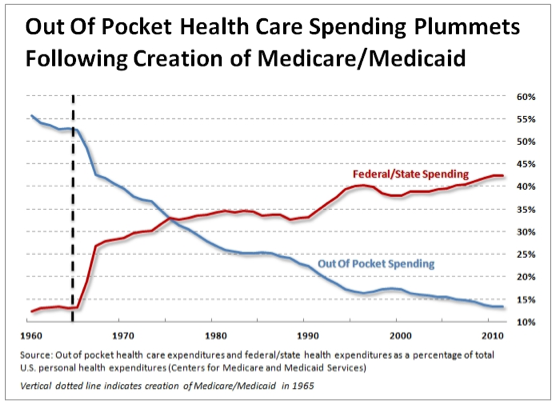1965 was an important year, the year Medicare and Medicaid were enacted. Congress didn’t know they had just created legislation that was going to make the 1970s a period of massive inflation in health care costs. Not surprising really, when new state and federal money and regulations are injected into an industry something is bound to go wrong.
Here is an excerpt from an article explaining the fiscal impacts:
In 1965, state and local governments spent $3.7 billion on civilian health care, while the federal government spent only $865 million. Two years later, state and local rose 30 percent to $4.8 billion, but federal spending went up 655 percent to $6.8 billion. By 1970, state expenditures would rise to $6.6 billion, and federal spending would reach $11.2 billion over twelve times what had been spent five years earlier. The money both the states and federal governments spent on personal civilian health care went from 10.9% of total national health expenditures in 1965 to 24.1% in 1970.
When spending increased and beneficiaries of these two programs realized they could consume health services with no constraint, medical inflation began and was the catalyst for some hysteria in Congress to rein in the problem they had created only a few years prior.
The article also outlined some of those programs:
-
Wage and price controls that were imposed by President Nixon in August, 1971. They were removed for most of the economy in January 1973, but retained for health care until April 30, 1974.
-
Legislation creating Professional Standards Review Organizations for Medicare was enacted in 1972. These were intended to supervise physician practice to ensure appropriate treatments and lengths of stay, and restrain costs.
-
The Federal HMO Act of 1973 provided seed money for HMOs that met certain federal qualifications, such as being not for profit, using community rating, providing a minimum set of benefits, and exempting HMOs from state insurance regulations on issues such as capitalization and reserves, board composition requirements, and advertising restrictions. It included a “dual choice” provision that required employers with over 25 employees to offer HMO options to their workers.
-
The National Health Planning and Resources Development Act of 1974 required states to establish elaborate bureaucracies to control the growth of hospitals and other health care facilities. These agencies included Health Systems Agencies (HSAs), State Health Planning and Development Agencies (SHPDAs), Statewide Health Coordinating Councils (SHCCs), and a host of other committees and agencies. These efforts were designed to implement Certificate of Need (CON) programs, through which hospitals and other facilities that wished to make capital outlays would have to get prior approval from the agencies.
Take a guess – these didn’t work very well. What happened was excess demand by Medicare had overrun supply of services and caused a surge in health care prices. So what did the government do? Well, economics didn’t play into it. They created this huge bureaucracy of health care agencies that again reduced supply.



